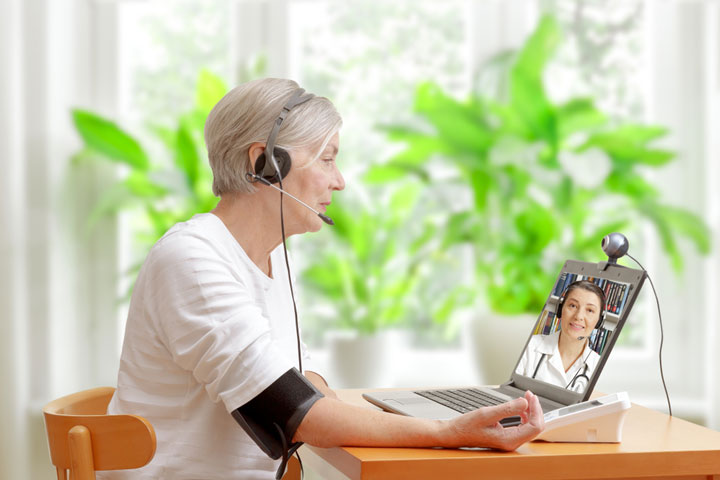The sudden and unexpected emergence of the COVID-19 pandemic presented many new challenges for healthcare delivery in 2020. Since then, much has changed in the way providers render primary care and specialty services across communities and patient populations.
Let’s take it back for a moment. In March 2020, the World Health Organization declared a pandemic due to the SARS-CoV2 virus, which spread across the world and, according to Woldometer, infected more than 600 million people and resulted in more than 6 million deaths worldwide. We haven’t witnessed anything like this in our lifetime. It created new challenges and exacerbated pre-existing issues in healthcare systems.
According to Doraiswamy and colleagues, Thomas and colleagues, and Zelmak and colleagues, telehealth played a critical role in healthcare delivery, with an unprecedented rise in usage during the 2020 lockdown period and after. As hospitals filled, primary care offices remained empty and closed. Telehealth served as the only and safest solution for healthcare access in many communities.
Stroke and the Rise of Telehealth – What Nurses Need To Know
Staying healthy: Advice for telehealth nurses
Many facilitators and barriers exist within telehealth. During the pandemic, patients could still have access to healthcare providers in real time remote visits using telephones or videoconferencing software. Healthcare provides efficiently used these services to assess, diagnosis, and provide treatment regimens for patients. This innovative approach enabled a solution-focused strategy for how patients engaged with healthcare, how providers delivered healthcare, and how insurance companies reimbursed services. Thomas and colleagues describe how clinicians across the globe mobilized or expanded available technology to maintain contact with patients, established new access, and explored uncharted methods of providing healthcare access for individuals in need.
Despite the evils of the pandemic, one important change was the expansion of private insurance reimbursement for telehealth services as well as Medicare and Medicaid expansion to reduce previously prohibitive barriers of telehealth services. The acceptance of this mode of healthcare delivery provides further confirmation of the importance of permitting telehealth as an option for healthcare delivery.
Smartphones and computers revolutionized access to the waiting rooms to see and hear clinician recommendations for care. Healthcare organizations also have successfully used remote monitoring and other forms of wireless communications to provide real-time assessment, diagnosis, and treatment for patients across various medical specialties.
However, increased access to technology doesn’t guarantee that patients can efficiently use these resources. According to Doraiswamy and colleagues and Fisher and Magin, social, structural, and economic barriers exist for many with low health and digital literacy or limited internet or computer access. Fisher and Magin emphasize that as healthcare providers, we should refrain from assuming that individuals with technology access inherently possess the skills to use it effectively. Nurses shouldn’t assess only for its suitability and available environmental support, but also confront the challenges linked to telehealth accessibility. Such challenges include the following:
- Limited health and digital literacy.
- Inadequate access to electronic devices, webcams, and other audiovisual equipment.
- Patient resistance to embracing telehealth as a viable substitute for in-person consultations.
- Unreliable internet connectivity, particularly among individuals residing in remote, underserved, or weather-affected regions.
- Limited patient privacy in shared living situations, confined spaces, or multi-generational households.
- The capacity of healthcare providers to conduct assessments, monitoring, and observations via webcam.
- Insufficient lighting and potential interference from background noise.
- Challenges posed by hearing, visual, and/or cognitive impairments.
Faced with these complexities, Fisher and Magin recommend that nurses and other healthcare professionals adopt innovative strategies to establish equitable telehealth accessibility for all patients.
Where do we go from here?
Everywhere! Anywhere! The post-pandemic model of healthcare delivery should reflect a more thoughtful utilization of telehealth services. The inclusion of a telehealth option empowers individuals to consider it an equal choice for selecting services and expands access to individual providers not tied to a walled structure. The ability to focus on all the inadequacies of a system certainly applies to how we utilize telehealth services; however, the good far outweighs any negative argument, simply because access to healthcare can be the difference between life and death. According to Thomas and colleagues, the sustainability of telehealth as a long-term solution to expanding healthcare access should include strategic efforts to develop a skilled workforce, empower consumers, improve financial support, and enhance telehealth platforms, with the intention of integrating telehealth as a routine care option. With these efforts, telehealth can become a part of the “new normal” for access to healthcare services and we can be partially thankful to the changes spurred by the pandemic.
Looking ahead, the post-pandemic healthcare model is expected to incorporate telehealth more thoughtfully. The integration of telehealth services provides individuals with an equal choice for healthcare, breaking down barriers associated with physical locations. The positive aspects of telehealth, such as increased access and convenience, outweigh potential shortcomings. Therefore, efforts should be directed toward establishing telehealth as a routine and sustainable option for healthcare delivery.
For the long-term success of telehealth, several strategies should be pursued, including the following:
- Workforce development: Train healthcare professionals to effectively use telehealth platforms and communicate with patients remotely.
- Consumer empowerment: Educate patients about telehealth and how to use the technology to access healthcare services.
- Financial support: Continue reimbursement and coverage of telehealth services by insurance companies and government programs.
- Technological improvement: Enhance telehealth platforms to ensure ease of use, security, and a seamless patient experience.
- Integration as routine care: Establish telehealth as a standard option for accessing healthcare services, even after the pandemic subsides.
The experience of the pandemic has accelerated the adoption of telehealth and highlighted its potential to expand healthcare access. As we move forward, the lessons learned from this crisis can shape a “new normal” in healthcare delivery, where telehealth plays a crucial role in providing accessible and convenient healthcare services to individuals across various communities.
The authors work at Johns Hopkins School of Nursing in Baltimore, Maryland. Tamar Rodney is and assistant professor and Diana Baptiste is an associate professor.
References
Centers for Medicare & Medicaid Services. Medicare telemedicine health care provider fact sheet. March 17, 2020. cms.gov/newsroom/fact-sheets/medicare-telemedicine-health-care-provider-fact-sheet
Doraiswamy S, Abraham A, Mamtani R, Cheema S. Use of telehealth during the COVID-19 pandemic: Scoping review. J Med Internet Res. 2020;22(12):e24087. doi:10.2196/24087
Fisher K, Magin P. The telehealth divide: Health inequity during the COVID-19 pandemic. Fam Pract.2022;39(3):547-9. doi:10.1093/fampra/cmab173
Thomas EE, Haydon HM, Mehrotra A, et al. Building on the momentum: Sustaining telehealth beyond COVID-19. J Telemed Telecare. 2022;28(4):301-8. doi:10.1177/1357633×20960638
World Health Organization. The true death toll of COVID-19: Estimating global excess mortality.who.int/data/stories/the-true-death-toll-of-covid-19-estimating-global-excess-mortality
Worldometer. COVID-19 coronavirus pandemic. 2023. https://www.worldometers.info/coronavirus/
Zemlak, J. L., Wilson, P., VanGraafeiland, B., & Rodney, T. (2021). Telehealth and the Psychiatric Mental Health Nurse Practitioner: Beyond the COVID-19 Pandemic. J Am Psychiatr Nurses Assoc, 10783903211045119. https://doi.org/10.1177/10783903211045119


















